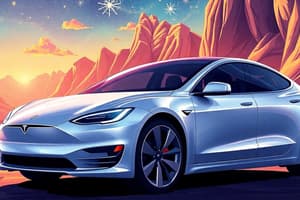Podcast
Questions and Answers
Which of the following strategies does Tesla employ to optimize vehicle performance and efficiency?
Which of the following strategies does Tesla employ to optimize vehicle performance and efficiency?
- Adopting a vertically integrated approach by designing and manufacturing key components in-house. (correct)
- Prioritizing aesthetic design over aerodynamic efficiency to appeal to a broader customer base.
- Relying solely on third-party software developers for vehicle control systems.
- Outsourcing key component manufacturing to specialized vendors.
Tesla primarily uses nickel-metal hydride batteries in its vehicles to ensure long-term reliability and cost-effectiveness.
Tesla primarily uses nickel-metal hydride batteries in its vehicles to ensure long-term reliability and cost-effectiveness.
False (B)
What is the primary purpose of Tesla's Gigafactories, in relation to manufacturing and production costs?
What is the primary purpose of Tesla's Gigafactories, in relation to manufacturing and production costs?
high-volume production and reduced manufacturing costs
Tesla's vehicle design philosophy combines aesthetics with ________ to maximize efficiency and range.
Tesla's vehicle design philosophy combines aesthetics with ________ to maximize efficiency and range.
Match each Tesla vehicle model with its corresponding body type:
Match each Tesla vehicle model with its corresponding body type:
Which of the following best describes Elon Musk's role in Tesla's innovation and design?
Which of the following best describes Elon Musk's role in Tesla's innovation and design?
Tesla exclusively uses induction motors across its entire vehicle lineup to ensure consistent performance characteristics.
Tesla exclusively uses induction motors across its entire vehicle lineup to ensure consistent performance characteristics.
Besides vehicles, what other energy-related products does Tesla design and manufacture?
Besides vehicles, what other energy-related products does Tesla design and manufacture?
Tesla's Autopilot and Full Self-Driving (FSD) features rely on a suite of cameras, ________, and AI to enable autonomous driving.
Tesla's Autopilot and Full Self-Driving (FSD) features rely on a suite of cameras, ________, and AI to enable autonomous driving.
What has been a persistent challenge for Tesla regarding production?
What has been a persistent challenge for Tesla regarding production?
Flashcards
Tesla's Vertical Integration
Tesla's Vertical Integration
Tesla uses a vertically integrated approach, handling design and manufacturing of key EV components to optimize performance and efficiency.
Tesla's Minimalist Interior
Tesla's Minimalist Interior
Tesla's minimalist interior designs feature large touchscreen interfaces, replacing traditional buttons and switches for a streamlined user experience.
Aerodynamic Design
Aerodynamic Design
Tesla emphasizes aerodynamic body shapes to reduce drag, increasing vehicle efficiency and range.
Aluminum Casting
Aluminum Casting
Signup and view all the flashcards
Over-the-Air (OTA) Updates
Over-the-Air (OTA) Updates
Signup and view all the flashcards
Tesla Energy Products
Tesla Energy Products
Signup and view all the flashcards
Tesla Supercharger Network
Tesla Supercharger Network
Signup and view all the flashcards
Autopilot and FSD
Autopilot and FSD
Signup and view all the flashcards
Musk's Leadership
Musk's Leadership
Signup and view all the flashcards
Lithium-Ion Batteries
Lithium-Ion Batteries
Signup and view all the flashcards
Study Notes
- Tesla's approach to design and technology represents a significant shift in the automotive industry, focusing on electric vehicles (EVs).
- Elon Musk's leadership has been pivotal in driving Tesla's innovation and design philosophy.
Core Design and Technology Principles
- Tesla emphasizes a vertically integrated approach, designing and manufacturing key components in-house.
- This includes battery technology, electric motors, software, and even some manufacturing equipment.
- The focus is to optimize performance and efficiency.
Battery Technology
- Tesla invests heavily in battery research and development to improve energy density, lifespan, and safety.
- Tesla uses lithium-ion batteries in its vehicles, constantly refining their chemistry and packaging.
- They aim to reduce battery costs and increase range.
- Tesla's partnership with Panasonic for battery cell production at the Gigafactory was crucial for scaling production.
- Tesla is now also developing its own battery cells.
Electric Motors
- Tesla uses different electric motor designs, like induction motors (Model S, Model X) and permanent magnet synchronous reluctance motors (Model 3, Model Y).
- These motors are designed for high power output, efficiency, and reliability.
- Tesla continuously works on motor improvements to enhance performance and reduce energy consumption.
Vehicle Design
- Tesla's vehicle design philosophy blends aesthetics with aerodynamics to maximize efficiency and range.
- Minimalist interior design features a large touchscreen interface.
- Over-the-air software updates improve vehicle performance and add new features.
Autopilot and Full Self-Driving (FSD)
- Tesla's Autopilot and FSD features use a suite of cameras, sensors, and AI to enable driver-assistance and autonomous driving capabilities.
- Tesla develops its own AI chips and software for processing sensor data.
- Continuous data collection and analysis improve self-driving capabilities through machine learning.
Manufacturing Innovation
- Tesla has pioneered advanced manufacturing techniques like aluminum casting and battery pack assembly.
- Gigafactories are designed for high-volume production and reduced manufacturing costs.
- Tesla aims to streamline production processes and improve manufacturing efficiency.
Energy Products
- Tesla also designs and manufactures energy storage products like Powerwall and Megapack.
- These products use similar battery technology found in Tesla vehicles.
- They support renewable energy integration and grid stabilization.
Charging Infrastructure
- Tesla has invested in a global network of Superchargers.
- They enable fast charging for long-distance travel.
- Tesla also offers home charging solutions.
Elon Musk's Role
- Musk's vision set ambitious goals for Tesla, pushing the boundaries of what was thought possible in the EV industry.
- He fostered a culture of innovation, risk-taking, and rapid iteration.
- Musk actively participates in product design and engineering decisions.
- He uses social media to communicate with customers and generate excitement around Tesla's products.
Key Innovations
- Over-the-air software updates for continuous improvement.
- Large touchscreen interfaces.
- Supercharger network for convenient charging.
- Advanced battery technology.
- Autopilot and FSD capabilities.
Design Philosophy
- Minimalist design emphasizing functionality and user experience.
- Aerodynamic body shapes for increased efficiency.
- Integration of technology into every aspect of the vehicle.
- Focus on safety features.
Challenges Faced
- Scaling production to meet demand has been a persistent challenge for Tesla.
- Battery production costs and supply chain constraints affect profitability.
- Regulatory hurdles and safety concerns surrounding Autopilot and FSD.
Impact on the Automotive Industry
- Tesla has accelerated the adoption of electric vehicles.
- It has forced traditional automakers to invest in EV technology.
- Tesla has demonstrated the potential of combining electric propulsion with advanced software and connectivity.
Future Trends
- Continued advancements in battery technology for increased range and reduced cost.
- Expansion of charging infrastructure.
- Further development of autonomous driving capabilities.
- Increased focus on sustainability and reducing environmental impact.
- Tesla is exploring new vehicle designs, production methods, and energy solutions.
Software and User Interface
- Tesla designs its own software for vehicle control, infotainment, and autonomous driving.
- The large touchscreen displays all relevant information and vehicle controls, replacing many traditional buttons and switches.
- Tesla regularly releases software updates that improve vehicle performance, add new features, and enhance the user experience.
Materials and Manufacturing
- Tesla uses aluminum for vehicle body structures to reduce weight and improve efficiency.
- They have pioneered large-scale aluminum casting techniques to simplify manufacturing and reduce production costs.
- Tesla is also experimenting with new materials and manufacturing processes to further improve vehicle performance and sustainability.
Environmental Impact
- Tesla's electric vehicles produce zero tailpipe emissions, reducing air pollution in urban areas.
- The overall environmental impact of EVs depends on the source of electricity used to charge them.
- Tesla is working to reduce the environmental footprint of its manufacturing operations.
- They are investing in renewable energy sources to power their factories and charging infrastructure.
Safety
- Tesla vehicles incorporate advanced safety features, including collision avoidance systems, automatic emergency braking, and lane departure warning.
- The Autopilot and FSD systems are designed to enhance safety by assisting drivers and preventing accidents.
- Tesla conducts extensive testing and continuous improvement of its safety systems.
- The company shares its safety data and collaborates with regulatory agencies to improve road safety.
Vehicle Models
- Model S: A flagship sedan that combines performance, range, and luxury.
- Model X: An SUV with distinctive falcon-wing doors and seating for up to seven passengers.
- Model 3: A mass-market sedan that made electric vehicles more accessible.
- Model Y: A compact SUV that offers a balance of practicality and performance.
- Cybertruck: A futuristic pickup truck with a stainless steel exterior and unconventional design.
- Roadster: A high-performance sports car that showcases Tesla's engineering capabilities.
Tesla Energy
- Powerwall: A home battery system that stores solar energy and provides backup power during outages.
- Megapack: A large-scale battery system used for grid stabilization and energy storage at utility-scale projects.
- Solar Panels and Solar Roof: Tesla offers solar energy generation products for residential and commercial customers.
- These products integrate with Tesla's energy storage systems.
Key Partnerships
- Panasonic: Partnered with Tesla on battery cell production at the Gigafactory.
- Other Suppliers: Tesla works with a network of suppliers for components and materials.
- Technology Companies: Collaborates with technology companies on software, sensors, and other technologies.
Community and Culture
- Tesla has a strong community of owners and enthusiasts who are passionate about electric vehicles.
- The company fosters a culture of innovation, risk-taking, and continuous improvement.
- Tesla encourages its employees to think outside the box and challenge conventional wisdom.
Marketing and Branding
- Tesla relies heavily on word-of-mouth marketing and social media to promote its products.
- The company has built a strong brand image.
- This emphasizes innovation, sustainability, and aspirational design.
- Tesla's marketing strategy focuses on the long-term benefits of electric vehicles and energy storage.
Global Expansion
- Tesla is expanding its manufacturing and sales operations globally.
- The company is building new Gigafactories.
- These serve key markets like China and Europe.
- Tesla is adapting its products and services to meet the needs of different regions.
Studying That Suits You
Use AI to generate personalized quizzes and flashcards to suit your learning preferences.




